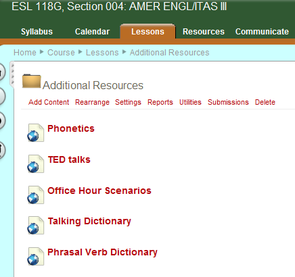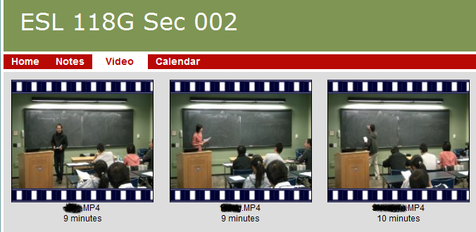Teaching with Technology

Reflection on Using Technology in the Classroom:
I've enjoyed the opportunity to use technology to supplement learning in and out of the classroom. I've been fortunate enough at Penn State to have a teacher's computer and projector in each classroom, so that I can support my explanations with further technological resources.
The technology that was integral to the courses I've taught included the course website, email, PowerPoint, and additional websites used in class. The course website allowed me to present the course material in an organized way that students could easily follow and access. Some of the other technology was used to help meet course objectives. For example, the extra links for students in ESL 118G gave them the opportunity to practice comprehension and speaking outside of class whenever they needed. Multiply.com also provided extra speaking practice, and helped students become more aware of their own pronunciation difficulties. Finally, corpus linguistics assisted students in learning the appropriate language for different teaching contexts, a major goal for the course. While these courses could be taught without such materials, using technology enhances students' learning and provides them with opportunities to interact in new ways. Using such technology can also help attract and maintain students' attention and interest in the course.
Besides yielding new opportunities and helping to keep the lesson exciting, another great advantage of using technology is that it reduces the amount of paper the class uses. When students submit assignments online, they don't need to print anything. I can comment directly on students' papers online, again without using paper. Students and teachers can communicate with each other, explore new ideas, and review information (such as assignment instructions), all while reducing their carbon footprints.
I've enjoyed the opportunity to use technology to supplement learning in and out of the classroom. I've been fortunate enough at Penn State to have a teacher's computer and projector in each classroom, so that I can support my explanations with further technological resources.
The technology that was integral to the courses I've taught included the course website, email, PowerPoint, and additional websites used in class. The course website allowed me to present the course material in an organized way that students could easily follow and access. Some of the other technology was used to help meet course objectives. For example, the extra links for students in ESL 118G gave them the opportunity to practice comprehension and speaking outside of class whenever they needed. Multiply.com also provided extra speaking practice, and helped students become more aware of their own pronunciation difficulties. Finally, corpus linguistics assisted students in learning the appropriate language for different teaching contexts, a major goal for the course. While these courses could be taught without such materials, using technology enhances students' learning and provides them with opportunities to interact in new ways. Using such technology can also help attract and maintain students' attention and interest in the course.
Besides yielding new opportunities and helping to keep the lesson exciting, another great advantage of using technology is that it reduces the amount of paper the class uses. When students submit assignments online, they don't need to print anything. I can comment directly on students' papers online, again without using paper. Students and teachers can communicate with each other, explore new ideas, and review information (such as assignment instructions), all while reducing their carbon footprints.

Course Web Space:
In all of the courses I've taught at Penn State, I've used the ANGEL course website system. Through ANGEL, it's easy to set up any information I may want to use in the course. Here are some of the things included in my ANGEL sites:
It is also possible to keep attendance and send electronic communication through the course website. The advantage of having a course website is that students can access course material anytime, anywhere. They can even view the material after the course has ended. In addition, the ANGEL site presents the material in a cohesive, organized way. Students can see how the material and assignments fit together as a unit, and keep track of their progress during the semester.
Above (right) is an example of the ANGEL site for ESL 015, Composition for American Academic Communication II.
In all of the courses I've taught at Penn State, I've used the ANGEL course website system. Through ANGEL, it's easy to set up any information I may want to use in the course. Here are some of the things included in my ANGEL sites:
- Syllabus and Course Schedule
- Dropboxes - students can upload their assignments
- Discussion Forums - students can post comments and respond to each others' comments
- Folders - including any information about assignments, example assignments, suggested links, etc.
It is also possible to keep attendance and send electronic communication through the course website. The advantage of having a course website is that students can access course material anytime, anywhere. They can even view the material after the course has ended. In addition, the ANGEL site presents the material in a cohesive, organized way. Students can see how the material and assignments fit together as a unit, and keep track of their progress during the semester.
Above (right) is an example of the ANGEL site for ESL 015, Composition for American Academic Communication II.

Links for Students:
I like to provide students with some links to extra resources they might find helpful throughout the course. I add to this folder as the semester progresses.
To the right is an example of some Additional Resources on the ESL 118G, American Oral English for ITAs III, ANGEL website.
I like to provide students with some links to extra resources they might find helpful throughout the course. I add to this folder as the semester progresses.
To the right is an example of some Additional Resources on the ESL 118G, American Oral English for ITAs III, ANGEL website.
- The Phonetics site allows students to view the location and manner in which different sounds of English are produced.
- TED talks are talks given by a variety of speakers on many different interesting topics. One of the benefits of this site for ESL students is that most talks include an interactive transcript, where you can click on the transcript, and the video will skip to that part of the talk. Some talks also have transcripts available in different languages.
- The link to Office Hour Scenarios provided students with an idea of how to handle different situations that might arise during office hours.
- The Talking Dictionary is a website that provides a definition and human pronunciation of words you search for.
- In the Phrasal Verb Dictionary, students can search for different phrasal verbs to see the meaning and an example sentence.
Example Presentations with Technology:
I frequently use PowerPoint presentations in my lessons. Students in my classes have reported that they find PowerPoint particularly useful. As language learners, it is helpful for them to have listening reinforced with visual materials. In addition, the PPT slides are posted to ANGEL after class, so students have the ability to review the slides whenever they like.
I also supplement lessons with video, audio, or websites whenever appropriate. The following PPT was used in ESL 118G to teach the distinction between the "æ" and "ɛ" sounds in American English. (See Teaching Materials for the complete lesson plan.) The PPT includes a link to a YouTube video, which was meant as an introduction to the lesson, and a link to a pronunciation site that depicts where and how different sounds are created in the mouth.
I was encouraged by the students' response to incorporating these materials into the lesson, and would like to increase my use of these resources in future lessons, if possible.
Click the link below to view the PPT.
I frequently use PowerPoint presentations in my lessons. Students in my classes have reported that they find PowerPoint particularly useful. As language learners, it is helpful for them to have listening reinforced with visual materials. In addition, the PPT slides are posted to ANGEL after class, so students have the ability to review the slides whenever they like.
I also supplement lessons with video, audio, or websites whenever appropriate. The following PPT was used in ESL 118G to teach the distinction between the "æ" and "ɛ" sounds in American English. (See Teaching Materials for the complete lesson plan.) The PPT includes a link to a YouTube video, which was meant as an introduction to the lesson, and a link to a pronunciation site that depicts where and how different sounds are created in the mouth.
I was encouraged by the students' response to incorporating these materials into the lesson, and would like to increase my use of these resources in future lessons, if possible.
Click the link below to view the PPT.
| ae_vs_e.pptx |
Electronic Communication with Students:
I often communicate with students via e-mail. I send them announcements and individual grades on assignments, as well as answering questions or setting up meetings. E-mail allows me to interact with my students outside of class, responding to any specific needs of individual students. It also is useful in reinforcing any announcements I made in class. When I make an oral announcement in class, it is helpful for visual learners to see the information in a textual format as well. Here's an example of an email I sent to ESL 118G students in Fall of 2010, reminding them of information about their final test:
I often communicate with students via e-mail. I send them announcements and individual grades on assignments, as well as answering questions or setting up meetings. E-mail allows me to interact with my students outside of class, responding to any specific needs of individual students. It also is useful in reinforcing any announcements I made in class. When I make an oral announcement in class, it is helpful for visual learners to see the information in a textual format as well. Here's an example of an email I sent to ESL 118G students in Fall of 2010, reminding them of information about their final test:
Pedagogical Innovation with Technology:
In ESL 118G, I was excited to incorporate a website called Multiply (www.multiply.com). Multiply is a social networking site where users can share media files, including photos, audio, and video. I began by creating a group for our class. An advantage of Multiply is that I was able to adjust the privacy settings so that only our members of our group (the class) could view the site. Multiply is free, but each user must create an account and log in with that account to use the site.
Our class used the website for audio and video assignments. For each of the 5 audio journal assignments during the semester, I created an event where students could "comment" with an audio reply. What's great about Multiply is that you can record audio directly to the site, without needing any recording equipment other than a microphone. After the students had submitted their audio journals, they then commented on a classmate's recordings.
Students also utilized the audio option if they wanted to practice the pronunciation of any particular sounds/words/phrases with me. They could record themselves saying a word, then I would give them feedback and repeat the word back to them.
Another function of the site that our class used was the ability to upload videos. In order to prepare students to become International Teaching Assistants in the future, they were required to present something within their field to the class. These presentations were video recorded, and the recordings uploaded to Multiply so the students could review them in the future.
Multiply was a good fit for our class, because it helped meet one of the course goals, which was extra speaking practice outside of class. Multiply made it easy for students to record their audio in one place, and to listen and respond to their classmates' recordings. Uploading students' videos was important as well, because an objective of the class was to increase students' awareness of their own teaching techniques and pronunciation difficulties. With the videos on the class Multiply site, the students were able to review their own work, and locate specific areas for improvement.
Overall, Multiply worked really well for our context. There were a few minor issues, however. A few students had problems recording their audio journals; for some reason the website did not allow them to save their recordings. Also, some students were not comfortable using the group site for individual practice, since other students could view their practice recordings.
Below is an example of some of the video presentations uploaded to the site.
In ESL 118G, I was excited to incorporate a website called Multiply (www.multiply.com). Multiply is a social networking site where users can share media files, including photos, audio, and video. I began by creating a group for our class. An advantage of Multiply is that I was able to adjust the privacy settings so that only our members of our group (the class) could view the site. Multiply is free, but each user must create an account and log in with that account to use the site.
Our class used the website for audio and video assignments. For each of the 5 audio journal assignments during the semester, I created an event where students could "comment" with an audio reply. What's great about Multiply is that you can record audio directly to the site, without needing any recording equipment other than a microphone. After the students had submitted their audio journals, they then commented on a classmate's recordings.
Students also utilized the audio option if they wanted to practice the pronunciation of any particular sounds/words/phrases with me. They could record themselves saying a word, then I would give them feedback and repeat the word back to them.
Another function of the site that our class used was the ability to upload videos. In order to prepare students to become International Teaching Assistants in the future, they were required to present something within their field to the class. These presentations were video recorded, and the recordings uploaded to Multiply so the students could review them in the future.
Multiply was a good fit for our class, because it helped meet one of the course goals, which was extra speaking practice outside of class. Multiply made it easy for students to record their audio in one place, and to listen and respond to their classmates' recordings. Uploading students' videos was important as well, because an objective of the class was to increase students' awareness of their own teaching techniques and pronunciation difficulties. With the videos on the class Multiply site, the students were able to review their own work, and locate specific areas for improvement.
Overall, Multiply worked really well for our context. There were a few minor issues, however. A few students had problems recording their audio journals; for some reason the website did not allow them to save their recordings. Also, some students were not comfortable using the group site for individual practice, since other students could view their practice recordings.
Below is an example of some of the video presentations uploaded to the site.
Additional Technology Used:
Another type of technology that supported my teaching was corpus linguistics. Corpus linguistics compiles instances of language use and organizes them so users can better understand how language is used in different contexts.
In ESL 118G, students learn about the types of language they should use in different settings as TAs (such as at office hours). In class, we examined transcripts of the language real TAs used in their office hours. Students learned different phrases for giving suggestions or directions, and learned about the level of formality that is expected in different contexts. The corpus that our class used is the Michigan Corpus of Academic Spoken English (or MICASE), found at http://micase.elicorpora.info/. Students were also encouraged to use MICASE outside of class whenever they had questions about how a word or phrase could be used effectively or appropriately.


